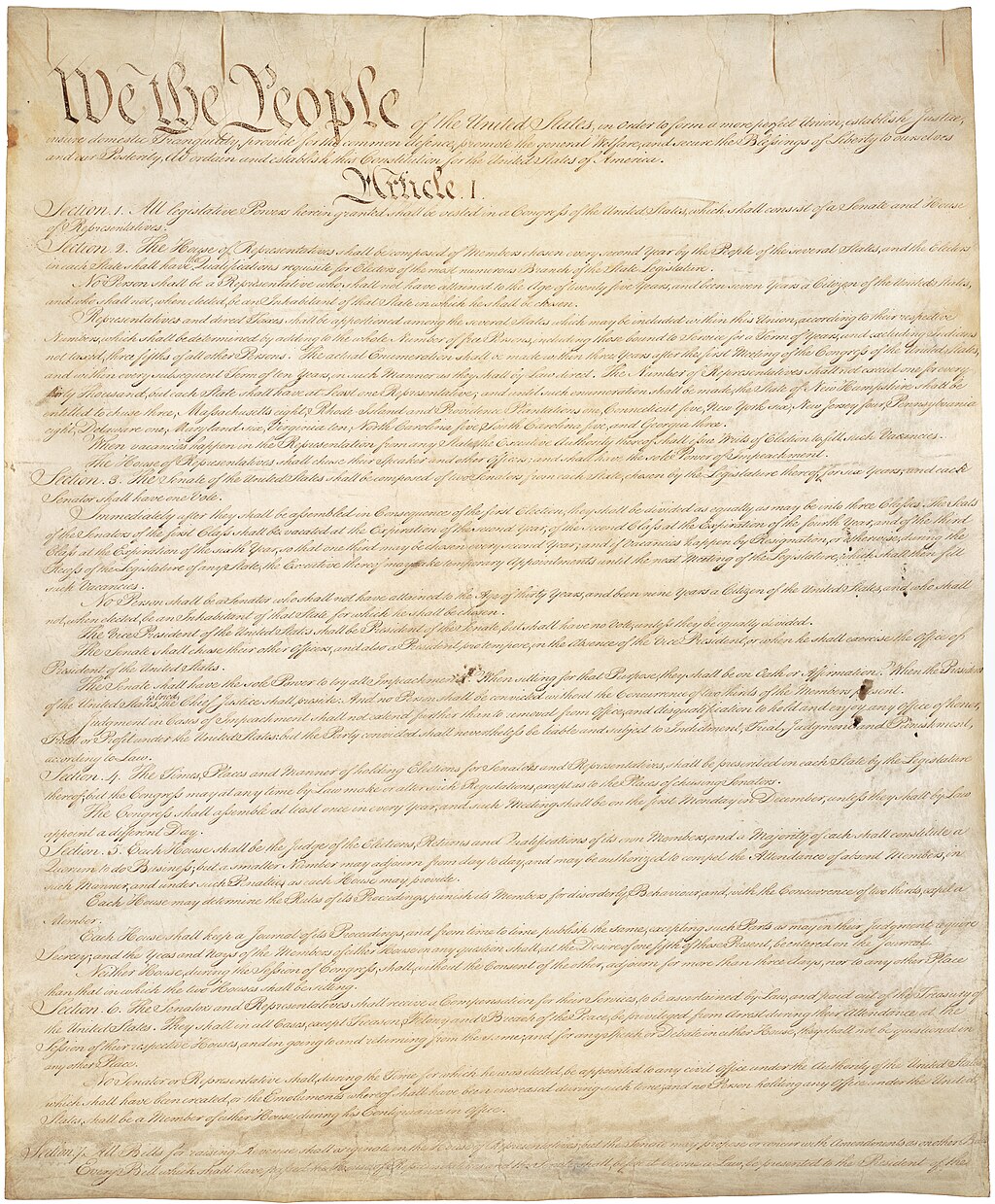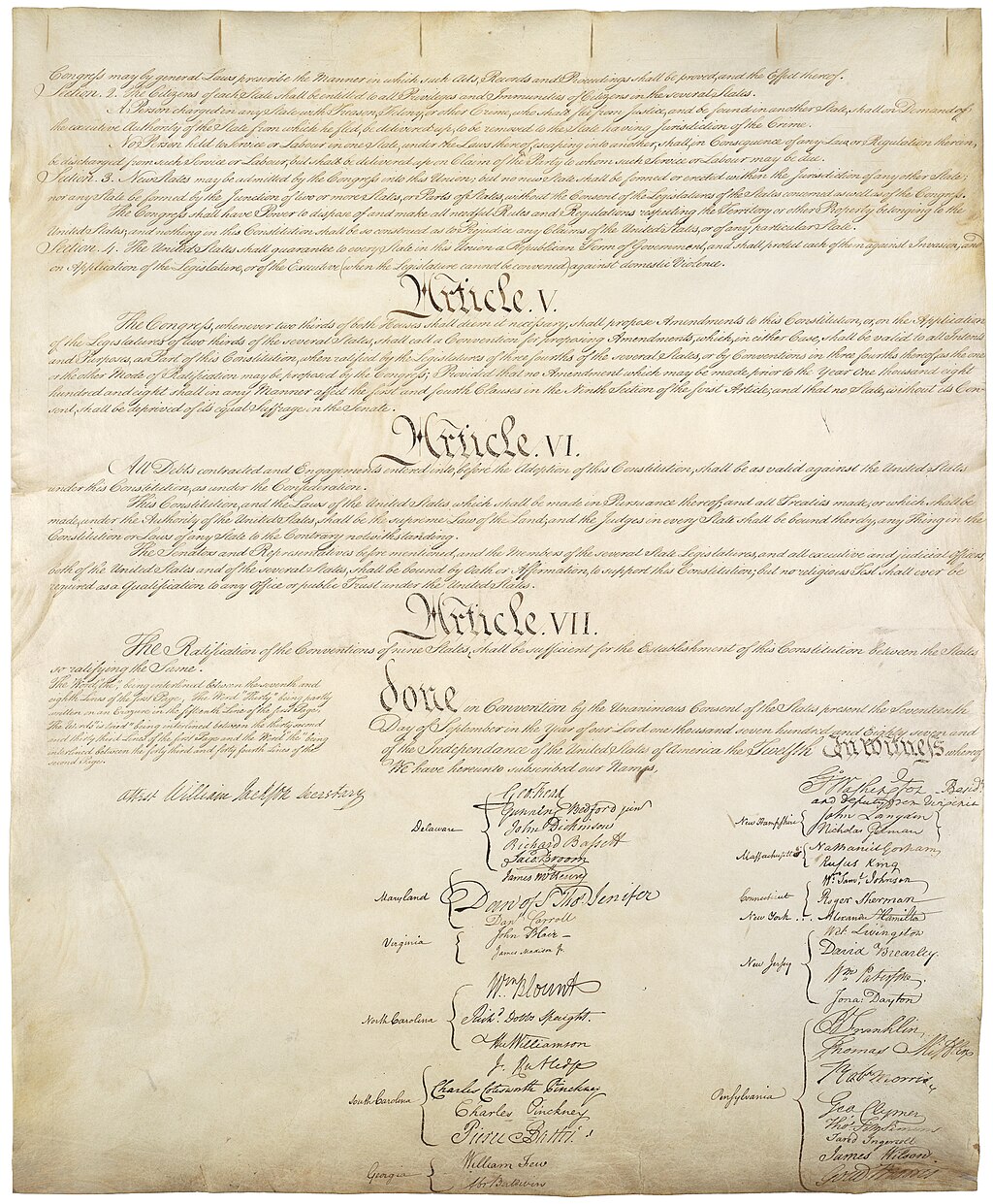The US Constitution : A Pillar of Democracy and the Foundation of American Governance
The US Constitution is, in its own words, the “supreme law of the country.” Accepted on September 17, 1787 by a convention meeting in Philadelphia, it has applied since March 4, 1789. Modified by twenty-seven amendments, it is one of the oldest written constitutions still applied.
This article delves into the history, structure, and enduring influence of the U.S. Constitution, highlighting its profound impact on the nation’s development and its enduring relevance in the modern world.
It is based on a strict separation of powers, thus establishing a presidential regime. Executive power rests with a President of the United States, who is both head of state and head of government. The legislative power is bicameral. This is the Congress, made up of two chambers: on the one hand the House of Representatives (lower house), which represents the citizens, and on the other hand the Senate (upper house), which represents the federated states. Only these chambers have the parliamentary initiative and vote the laws, as well as the federal budget. Finally, the judiciary has at its apex the Supreme Court, which oversees compliance with the Constitution by the laws, the federated states and the organs of the federal state. The Constitution thus provides through this system the balance of powers as well as their collaboration (in English “checks and balances”).
Originally ratified by 13 federated states, today numbering fifty, it creates a federal state. Although the Constitution and the laws of the United States are binding on the various federated states, very broad prerogatives are reserved for them. The government is, from the outset, of the republican type and based on the sovereignty of the people. Its democratic character in the current sense of the term, with universal suffrage, appears more gradually, sometimes through amendments, more often by changing laws or reversing case law.
Branch of the US Constitution
1. Legislative: Congress (The US Capitol) > House of Representative > Senate
2. Executive: Administratives (White House) > President > Vice President > Cabinet
3. Judicial: Supreme Court (Supreme Court in Washington DC) > Chief Justices > Courts of Appeal > Distric Courts
Separation of powers
The first three articles are each devoted to one of the three powers, in the legislative, executive and judicial arrangements. They strongly mark the distinction and separation of powers, with the first sentence of each, all three on the same model.
1. All legislative powers conferred by this Constitution shall be vested in the United States Congress, consisting of the Senate and the House of Representatives.
2. Executive power shall be vested in the President of the United States.
3. The judicial power of the United States shall be vested in the Supreme Court and lower courts as Congress may from time to time direct.
Historical Context:
The roots of the U.S. Constitution can be traced back to the dissatisfaction with the Articles of Confederation, which proved inadequate in governing the newly independent states after the American Revolution. The Constitutional Convention of 1787 convened in Philadelphia to address these shortcomings and create a stronger, unified framework of government. Over several months of intense debates and compromises, the delegates drafted the Constitution, reflecting the shared belief in a representative republic that derived its authority from the people.
Structure and Principles:
The Constitution is divided into a preamble and seven articles, outlining the structure and powers of the federal government. It establishes three separate branches: the legislative branch (Congress), the executive branch (the President), and the judicial branch (the Supreme Court). This separation of powers is designed to prevent the concentration of authority and ensure a system of checks and balances, fostering a government accountable to the people.
Embedded within the Constitution are fundamental principles, such as federalism, popular sovereignty, and the protection of individual rights. The Bill of Rights, the first ten amendments ratified in 1791, guarantees essential liberties, including freedom of speech, religion, and due process of law, setting a precedent for constitutional rights worldwide.
Evolving Interpretations:
The U.S. Constitution’s enduring strength lies in its adaptability to changing times and societal needs. Over the centuries, the interpretation of its provisions has evolved through landmark Supreme Court decisions, reflecting shifts in American values and expanding the scope of civil rights protections. For instance, landmark cases such as Brown v. Board of Education and Obergefell v. Hodges have significantly impacted the nation’s approach to racial segregation and same-sex marriage, respectively.
Global Influence:
The U.S. Constitution’s influence extends beyond American borders, serving as a model for democratic nations worldwide. Its emphasis on individual freedoms and democratic principles has inspired numerous constitutions and charters of rights globally, reflecting the enduring legacy of the American experiment.
Miniature version of the US Constitution. Almanaque Lusofonista, Public domain, via Wikimedia Commons
What is written in the US Constitution book?
Article I: legislative power
Article I establishes a bicameral United States Congress to pass laws. The House of Representatives is renewed every two years, by direct suffrage, the states are represented in proportion to their population. The senate is made up of two senators for each state, elected by the state legislature (amended by the 17th Amendment, which provides for direct suffrage). It is renewed by thirds every two years. The texts must be voted on by the two chambers, which both have the initiative for laws, except in tax matters, where the initiative is reserved for the Chamber of Representatives. The House of Representatives can impeach the most important officials, including the President of the United States, who will then be judged by the Senate. The president can veto a law, in which case both houses of congress must each vote on it by a two-thirds majority for it to become law. The article lists the areas in which Congress has legislative jurisdiction. Some powers are expressly withdrawn from the States.
Article II: the executive power
Article II creates the functions of president and vice-president of the United States, and defines their mode of election, complex, and slightly modified by the XIIth amendment. Executive power rests with the president, who is also commander-in-chief of the army, navy, and state militias when mobilized by the United States. He appoints senior federal officials and judges, with the approval of the senate. The prerogatives of the vice-president are limited to succeeding the president if he is prevented by death or for another reason from completing his term, as well as (article I) presiding over the Senate and deciding there in the event of a tie.
Article III: the judicial power
Article III creates the Supreme Court of the United States. Federal judges, in the Supreme Court as well as in other courts, are appointed for life. The article defines the jurisdiction of the federal courts, which includes the Constitution, and federal laws over which Congress gives them jurisdiction, as well as disputes between parties not belonging to the same state. Except in a few limited cases where it judges in first instance (in particular for cases involving ambassadors, consuls, or ministers), the Supreme Court is a court of appeal. Criminal cases must be tried by a jury in the state where the offense was committed. A restrictive definition of treason is given.
Article IV: States
Main article: Article IV of the United States Constitution.
Article 4 deals with the rights and obligations of States. They must recognize the laws and judgments of other states, and treat the citizens of other states equally with their own. Persons prosecuted by the justice of a State must be handed over to it by the other States, as well as runaway slaves (the law on runaway slaves having been canceled by the abolition of slavery, formalized by the XIIIth amendment of the Constitution).
Article V: amendment procedures
Amendments can be proposed either by Congress, with each house voting by a two-thirds majority, or by a convention that will be called if two-thirds of the states so request. They must then be ratified by three quarters of the States. Some modifications prohibit until 1808, then definitively, the possibility of removing the right of each State to an equal representation in the senate without its agreement.
Article VI: miscellaneous provisions
Treaties and agreements made by the United States under the Articles of Confederation remain valid. The Constitution and laws of the United States are binding on the states. At both the federal and state levels, legislators, judges, and officials must swear an oath to uphold the United States Constitution.
Article VII: Ratification
Main article: Article VII of the United States Constitution.
The Constitution will take effect between the States which have ratified it, as soon as they are nine in number.
Amendments
Amendments to the Constitution are provided for in Article V. Twenty-seven have been ratified. Of the two possible procedures, Congress proposal or convention requested by two-thirds of the States, only the first was used. But before Congress decided to propose the XVIIth Amendment itself (direct election of senators) in 1912, all that was needed was the vote of one state to call a convention. It is recognized that Congress can reconsider the proposed amendments, nor the States their ratification; but that a State which initially refused to ratify may subsequently reconsider this refusal. The 27th Amendment, ratified in 1992, was proposed by the First Congress in 1789, more than two hundred years earlier. All other adopted amendments were ratified in less than five years, most often the ratification process takes about a year. The dates given below are those when Congress passed the amendments, and those when the last necessary state voted to ratify.
From the 1st to the 10th Amendment: the Bill of Rights
The first ten amendments form the Bill of Rights. They affirm the rights of citizens, in the form of an explicit limitation of the powers of the State, particularly in judicial matters. It is not a question of positive rights that the State must guarantee to the citizen, but of actions from which it must abstain with regard to him. All these amendments were proposed by the first Congress on September 25, 1789 and ratified on December 15, 1791
1st amendment
Congress shall make no law affecting the establishment or interdicting the free exercise of any religion, or restricting freedom of speech or of the press, or the right of the people to assemble peacefully and address petitions to the government for redress of his grievances.
2nd Amendment
A well-organized militia being necessary for the security of a free state, the right of the people to keep and bear arms will not be infringed.
Third Amendment
The State may not house troops in private homes in times of peace. In time of war, this should only be done under the conditions provided by law.
Fourth amendment
The right of citizens to be guaranteed in their person, their domicile, their papers and effects, against unjustified searches and seizures will not be violated, and no warrant will be issued, except on serious presumption, corroborated by oath or declaration, nor without the warrant specifically describing the place to be searched and the persons or things to be seized.
Fifth amendment
No person shall be held to account for a capital or infamous crime without an indictment, spontaneous or induced, of a grand jury, except in cases of crimes committed while the accused was serving in the ground or naval forces, or in the militia, in time of war or public emergency; no one can be twice threatened in his life or in his body for the same crime; no one may, in a criminal case, be compelled to testify against himself, nor be deprived of his life, liberty or property without due legal process; no private property may be expropriated in the public interest without just compensation.
6th amendment
In all criminal proceedings, the accused shall have the right to be tried promptly and publicly by an impartial jury of the State and district where the crime was committed — the district having been previously delimited by law —, to be informed of the nature and cause of the accusation, to be confronted with the witnesses for the prosecution, to have legal means to compel the appearance of the witnesses for the defense, and to be assisted by counsel for his defence.
Case law:
- May 26, 2009: Montejo v. Louisiana (presence of lawyers during police interrogations).
- March 31, 2010: Padilla v. Kentucky. The Court requires lawyers to warn their foreign client of the likelihood of deportation in the event of a guilty plea. Writing for the majority, Justice Stevens indeed considered that deportation constituted “an integral part – sometimes the most important part – of the condemnation which can be imposed on non-citizens pleading guilty to certain crimes”. In other words, expulsion is considered a penalty.
VIIth amendment
In common law trials where the value in dispute shall exceed twenty dollars, the right to trial by jury shall be observed, and no fact adjudged by a jury shall be reconsidered in any court of the United States except under the rules of common right.
VIIIth amendment
Excessive bail and fines, as well as cruel or exceptional punishment, are prohibited.
IXth Amendment
The listing of rights in the previous amendments should not be interpreted as denying the existence of other rights.
Xth amendment
Main article: Tenth Amendment to the United States Constitution
The powers which are not delegated to the United States by the Constitution, and the exercise of which is not prohibited by it to the States, are reserved to the States respectively, or to the people.
Before the Civil War
XIth Amendment
Federal courts cannot hear suits brought against one state by a citizen of another state or a foreign national.
Twelfth amendment
The procedure for the presidential election is modified, so that the president and the vice-president are elected on separate ballots (rather than choosing as vice-president the second in the election).
Reconstruction Amendments
After the Civil War, reconstruction began in the south. The southern states are militarily occupied, their institutions are suspended. Congress proposes three amendments, all three related to the question of slavery and its aftermath, all three restricting the powers of the states. Each of these amendments ends with “Congress shall have power to give effect to the provisions of this article by appropriate legislation”. Congress conditions the readmission of Southern states to their ratification.
XIIIth Amendment
Main article: Thirteenth Amendment to the United States Constitution
Slavery is strictly prohibited on the territory of the United States and any territory under its jurisdiction, except when it represents a “punishment of a crime of which the culprit has been duly convicted”.
XIVth Amendment
Anyone born in the United States is a citizen. States cannot interfere with their life, liberty, or property without due process, and owe everyone the equal protection of the law. Representation in Congress and in the presidential election of states that do not grant universal suffrage (male, over 21) is reduced in proportion to the number of people banned from voting. Persons who assisted in the rebellion are barred from official duties in the United States government. Debts incurred by Confederate States in rebellion against the United States are void, no compensation can be claimed for the emancipation of slaves.
XVth Amendment
The right to vote cannot be restricted or denied because of race or a previous condition of servitude.
20th century amendments
Twelve amendments were ratified in the 20th century. Many are technical corrections to Article I or Article II, the two most important being the election of senators by direct suffrage, and the ineligibility of the president beyond two terms. Three relate to the right to vote, that of women, that of people over 18, and the prohibition of conditioning the right to vote on the payment of a tax. It is also necessary to note the legalization of the direct tax on the income (article II imposed that the federal taxes are proportionate to the population of the States), and finally the establishment, then the suppression, of prohibition.
Beginning with the 20th Amendment, Congress generally incorporates into its enactments a seven-year time limit for ratification.
XVIth Amendment
The federal state can levy income tax.
XVIIth Amendment
Senators are elected by direct suffrage.
XVIIIth Amendment
Prohibition of alcoholic beverages. The manufacture, sale, consumption, transport, import, and export are prohibited.
Ratified in 1919, it was repealed in 1933 (by the 21st Amendment) and the only amendment to the Constitution to have been repealed.
XIX Amendment
The right to vote cannot be restricted or denied on the basis of sex.
XX Amendment
The terms of the president and Congress begin in January, instead of March previously. The amendment also clarifies a few points on the succession of the president by the vice-president.
XXIst amendment
Abolition of the 18th Amendment, end of Prohibition.
XXII Amendment
Limitation to two presidential terms (only Franklin Roosevelt did more, three and a fourth briefly started, interrupted by his death).
XXIII Amendment
Participation of the District of Columbia (Washington D. C.) in the presidential election.
Amendment XXIV
The right to vote cannot be restricted or refused due to non-payment of tax.
Amendment XXV
Precision on the replacement or the succession in the event of temporary or permanent vacancy of the presidency.
XXVIth Amendment
The right to vote of persons over 18 cannot be restricted.
Amendment XXVII
Laws increasing the remuneration of representatives or senators cannot take effect until after the election to the House of Representatives following their vote.
Original manuscript of the US Constitution

First page out of 4, of the official copy of the Constitution signed by the delegates. A print run of 500 copies of the final version preceded this copy. National Archives and Records Administration, Public domain, via Wikimedia Commons

2nd page out of 4, of the original manuscript of the US Constitution. National Archives and Records Administration, Public domain, via Wikimedia Commons

Original manuscript of the Constitution, page 3 out of 4. National Archives and Records Administration, Public domain, via Wikimedia Commons

Naskah asli UUD, halaman 4/4, dengan tanda tangan perwakilan dari 13 Negara Bagian. National Archives and Records Administration, Public domain, via Wikimedia Commons
Signatures
The draft constitution was adopted on September 17, 1787, and signed by 39 of the 42 representatives present: George Mason, Edmund Randolph and Elbridge Gerry refused to put their signatures on the document. This was then forwarded to Congress.
| George Washington — The Chairman of the Convention and Representative from Virginia | |||||
| Delaware |
| New Hampshire |
| ||
| Gunning Bedford Jr. | Nicholas Gilman | ||||
| John Dickinson | Massachusetts | Nathaniel Gorham | |||
| Richard Bassett | Rufus King | ||||
| Jacob Broom | Connecticut |
| |||
| Maryland |
| Roger Sherman | |||
| Daniel or St. Thomas Jenifer | New York |
| |||
| Daniel Carroll | New Jersey | William Livingston | |||
| Virginia |
| David Brearley | |||
| James Madison | William Paterson | ||||
| North Carolina |
| Jonathan Dayton | |||
| Richard Dobbs Spaight | Pennsylvania |
| |||
| Hugh Williamson | Thomas Mifflin | ||||
| South Carolina |
| Robert Morris | |||
| Charles Cotesworth Pinckney | George Clymer | ||||
| Charles Pinckney | Thomas Fitzsimons | ||||
| Pierce Butler | Jared Ingersoll | ||||
| Georgia | William Few | James Wilson | |||
| Abraham Baldwin | Gouverneur Morris | ||||
Conclusion
The U.S. Constitution remains a cornerstone of American democracy and a testament to the foresight of the nation’s founding fathers. Its enduring impact on the development of democratic governance, its adaptability to changing times, and its global influence showcase its enduring relevance and significance. As the United States continues to grapple with new challenges and opportunities, the Constitution stands as a guiding light, upholding the principles of freedom, equality, and justice that continue to define the nation’s identity.
Sources: PinterPandai, The White House, Cornell University



